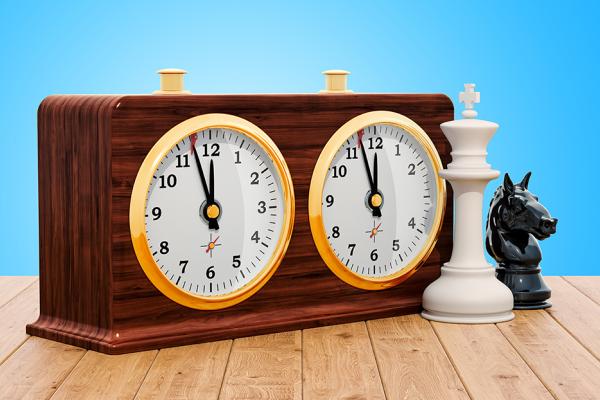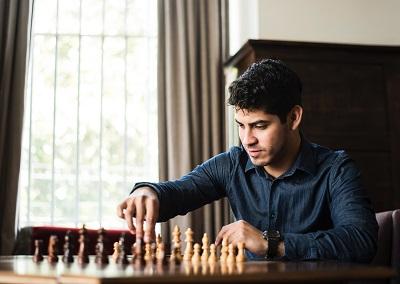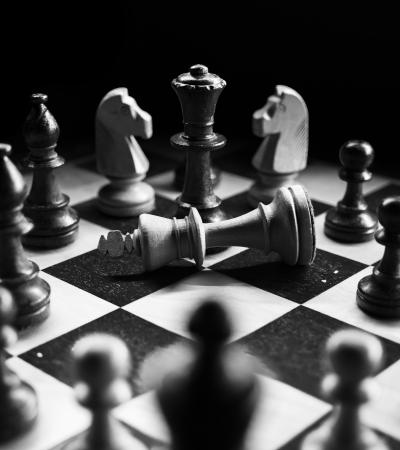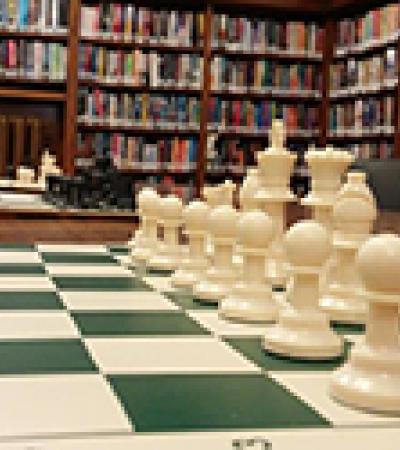Does your library host a chess program? This game is one of the quintessential activities that transcends age, culture, class, and even language. Once you open your doors to chess players, you may be surprised at how many diverse people will arrive eager to play. It's an excellent fit for a library hoping to establish itself as a place open to everyone.

At Chattahoochee Valley Libraries (CVL), we began an adult chess program in 2017. The response from our community was extraordinary. All sorts of new patrons appeared, asking “is this where chess is?”
We learned that there was a rag-tag, word-of-mouth chess group in our city. At last, the public library was hosting a program for them! There may be a similar group in your library’s community, too.
One of the frequent requests we received was to host a tournament. But I kept thinking to myself, I have no idea how to run a tournament! Nonetheless, the idea’s momentum was greater than my resistance. So, with the help of a volunteer with tournament experience, it finally happened. Here are the basics of what I learned.
What does a chess tournament look like?
The day of your library’s first tournament is finally here. You arrive to open the meeting room and see a few people waiting outside already. Some are carrying their own chess sets in bags with their names embroidered on the outside. There are adults, young adults and a few children. As you lay out your library’s chessboards on the tables, more people trickle in. There’s someone who barely speaks English, but he loves to play. There’s a dad who’s excited to help his son learn. There are two tween sisters who usually like to play against each other.
Sixteen people end up attending. Some have never used a chess clock before. Others have played in tournaments affiliated with the US Chess Federation (USCF) or Federation Internationale des Echecs (FIDE). The one thing that all of these people have in common is that they’re excited to compete today.
Once it’s time, you pair the players, they take their seats, and the matches begin. Soon, you can hear losers groaning and winners breathing sighs of relief. You assign points, post the standings and pair players again for the next round.
Your library has other events scheduled, so you can only use your meeting space for a couple of hours. To ensure that everyone plays enough rounds, you planned ahead and scheduled a second session later. The next week, the players arrive again and the event continues. After a few more rounds, you announce your top winners!
Everyone had a great time, and the event ran smoothly. But behind the scenes, you were frantically figuring out all of the pairing, scorekeeping and what to do if an argument breaks out.
This is similar to what our CVL tournament looked like, but yours will probably be unique. Maybe you’re doing this for children, or maybe you’ll have more adults. But whether you’re planning for 50 veteran adult players or 5 teens, there are some universal considerations.
Materials
In our hypothetical tournament of 16 players, you would need these materials:
- Eight sets
- Eight clocks
- Signs marked “1” through “8” to label each set
- Score sheets for writing moves
- A computer with a printer for pairings and scores
- Chess tournament software
- Pencils and paper
- Prizes for the winners
Adjustments will be necessary for your own tournament. For instance, the number of sets and clocks will have to match your number of players, and a whiteboard can substitute a printer. You can avoid using software if you're comfortable calculating pairings and scores by hand.
You may also want a copy of "US Chess Federation’s Official Rules of Chess." Don’t feel intimidated and think you must memorize all of its 370 pages, but it can explain the logistics of pairing, tie breaking and so forth with much more detail than this article.
Tips:
- This may go without saying, but you'll need to know the basic rules of chess. Otherwise, you’ll have trouble following all of these procedures. And if you’re directing your tournament by yourself, then you may have to be the referee who decides whether or not a player was allowed to castle during their last move.
- Tournament software typically costs between $100 and $150, but most companies provide free evaluation periods suitable for small tournaments.
- Key chapters of "US Chess Federation’s Official Rules of Chess" are free to download here.

Chess clocks
If you've never used a chess clock before, it's hardly more complicated than playing without one. Each player has a clock that runs during that player’s turn and pauses during the other player’s turn. If your clock runs out of time, then you lose. It keeps the games lively!
Unless your library can allow your event to run indefinitely, clocks ensure that it finishes before closing time. The timer for each clock is called a “time control.” Picking an appropriate time control for your tournament only requires a little math: take your number of rounds, divide by the amount of time you’ll spend playing, subtract a few minutes between rounds for breaks, divide by two (remember, a chess clock is actually two clocks), et voilà, there’s your time control.
((Total minutes available ÷ number of rounds) - time for breaks) ÷ 2 = Time control.
For example, in our tournament, we had three hours, four rounds, and five-minute breaks: ((180÷4)-5)÷2 = 20-minute time control at most. If your library doesn’t have chess clocks, or not enough for all of your players, there is a free “Chess Clock” app your players can download for their iOS and Android phones. If you instruct your players to use their phones, you should ensure they silence notifications and put their phones on airplane mode.
Tips:
- Not sure what time control to use for your tournament? Before you begin, let your players vote on it! Just make sure you set an appropriate limit.
- If you’re worried about phones disturbing games, announce a rule stating that if a player’s phone is being used as a clock and that phone receives a notification or a call, then that player loses the match. That may seem harsh, but players are usually diligent about silencing phones after hearing that!
Pairing and scoring players
There are two common systems to pair players during a tournament: “round robin” and “Swiss.” In either system, players are scored the same way. The winner of a match receives one point, and the loser receives zero. If there is a draw, they each receive one half-point. The overall winner is determined by who has the most points by the end of all the rounds.
Round robin pairings have every player compete with every other player. They require as many rounds as there are players, or as many minus one (it depends on whether there’s an even or odd number of players). Section 12 of the USCF rulebook has pairing tables you can use that will ensure everyone gets equal sides on black and white. Chess pairing tables are also readily available on many chess websites.
Round robin is only occasionally used because it’s hungry for time. If more than a few players attend, then it will require many hours of playing.
Swiss is what you’ll want for a shorter event. Players won’t play every other player. Instead, there will only be enough rounds necessary to determine an overall winner. The number of players should be equal to 2n, where n equals the number of rounds. For example, 16 players will only require 4 rounds (24=16). But suppose twice that number show up, and you have 32 players. With the Swiss system, we only have to add one more round (25=32) instead of doubling the length of the entire event.
Swiss scales efficiently but requires some technique to be effective. You must ensure that no two players play each other twice. After the first round, players should be paired by their current score. This means that players with zero points will be paired together, players with one point will be paired together and so on.

When possible, you should try to assign players an equal number of rounds on white and black, and you should try to pair players with similar skill levels together. However, the nature of Swiss means that these are ideals that won’t always be possible.
When the 16 players in our example complete all the rounds, you’ll end up with one in first place, four in second, six in third, four in fourth, and one in fifth. As you probably noticed, there are a lot of ties for the middle ranks. If you want a clear second and third place, then this is where Swiss can get complicated.
One easy tie-break method is to add the cumulative (running) scores for each round. Suppose that Andy and Harry are both tied with three points. Andy’s results were: win, loss, win, win. This means Andy’s scoresheet would read “1, 0, 1, 1,” and his cumulative score would be 1+1+2+3=7. Harry’s results were: win, win, loss, win, so his cumulative score would be 1+2+2+3=8. Harry would then be ahead of Andy. This may seem arbitrary at first, but the logic is that Harry must have played harder opponents because he won games earlier than Andy. (Swiss effectively pairs winners with winners and losers with losers.) Section 34E3 of the USCF rulebook explains cumulative scoring in more detail.
Cumulative tie-breaks aren’t always adequate, such as if two players are tied for first place because their final match was a draw. There are several other tie-break methods you can use as well, such as who played as black more may be scored higher, or who had higher-rated opponents may be scored higher. Many players prefer these methods, but they are much more complicated. If you're using tournament software, then let it calculate them for you.
Finally, there’s the situation of odd player numbers. In either paring system, the odd-person-out each round is assigned a “bye,” which is usually worth either one or one-half of a point. Your pairings should try to ensure that no player is given more than one bye. Also, bye points don't count in tie-breaks.
Tips:
- Assign players to play at specific sets. It will keep the event flowing orderly.
- Don’t pair direct relatives together. Those siblings who were hoping to play each other will get to make some new friends today.
- If you expect that you’ll have to assign a bye each round, you can use a sign-up sheet to let your players volunteer as the odd-person out.
Ratings
Some of your players may ask you about ratings. Organizations like USCF or FIDE will “rate” their members’ performance across games. (Official titles like “grandmaster” are also tied to ratings.) USCF only rates their dues-paying members, and they only rate games played at USCF-affiliated events. This may be at odds with your library if you need to keep your program open to the public.
It’s perfectly possible to run a tournament without ratings, but they can be used to break ties or inform your pairing system to create more even matchups. If you’re using software (or if you enjoy doing math problems by hand), you can run your own in-house rating system.
Tip:
- Even if you’re not using ratings, you can ask your players if they’re rated before your tournament begins. If any of them have proximate ratings, you can pair them together for the first round.
Other rules to consider
Writing moves is required for players in USCF tournaments, but that requirement may not be appropriate for a library event. You can still encourage players to record their games if they know how. Recording and studying past games is an excellent learning strategy.
Touch-move, requiring that a player move a piece after touching it, is a rule employed by most, if not all, tournaments.
Scenarios
Planning for every possible problem is a task beyond this article, but here are a few situations to think about:
Scenario 1: Laura hovers her hand over a piece but doesn’t move it. Her opponent, Bob, says she touched it and has to move it, but she say she didn’t touch it. What do you do?
Suggested solution: Unless a neutral witness can confirm what happened, you should err on Laura’s side. Let her continue, but advise her to avoid hovering her hands in the future. (See: USCF rulebook § 10B.)
Scenario 2: Pete sees that his clock has reached zero but his opponent, Dale, doesn’t notice. With Dale none the wiser, Pete keeps playing. Soon, Dale’s clock also runs out. When Dale notices that both clocks are at zero, he claims he should win on time because Pete’s ran out first. What do you do?
Suggested solution: Watching the clock is the responsibility of both players. Because both clocks have run out, neither player a right to win on time. They either keep playing or call a draw. Let this be a lesson for Dale to always watch the clock! (See: USCF rulebook § 16T.)
Scenario 3: Audrey moved her bishop to put Lucy in check. Lucy didn’t notice and then moved her queen to checkmate Audrey. Audrey says the checkmate doesn’t count because Lucy is still in check herself. Who’s right?
Suggested solution: Declaring “check” when checking an opponent is a courtesy, but not a requirement. Lucy’s move was illegal, so she must take it back and try again. If touch-move is in effect, she must still move her queen as long as the queen has a legal move. (See: USCF rulebook § 11D.)
Prizes
Library budgets are tight, and players are usually happy to just compete, but why not add some incentive? Trophies are inexpensive, and you can easily engrave them with your library’s name or logo.
Another good prize is a chess set. Especially if you expect youth to attend, a new set is a great way to help “spread the religion” to them. For adults, a nice chess book can also be a good prize (and besides, you are a library after all).
Final thoughts
Remember, a fun chess tournament doesn’t just happen. Getting a group of chess enthusiasts together in a room is good for a free-play session, but a tournament requires expertise and planning by a tournament director. That director could be you, or you may be able to wrangle the assistance of a volunteer with tournament experience. Either way, make sure you're always thinking three moves ahead to ensure a smooth operation.



